First impressions with the Aliph Jawbone II Bluetooth Headset
I’ve had a lot of bluetooth headsets in the last 8 or so years, ranging from Jabra to Motorola to Samsung, BlueAnt and others. There are always positives and negatives about each and every headset I’ve owned; more than enough to rant about here.
Now that I’m taking and making meetings while on a very busy and noisy train every day, being on mute most of the call just isn’t feasible. I needed to step up the noise cancellation to make myself more useful and more productive on these calls. I also spend a lot of time on the phone on the subway, walking in the busy streets of New York and lots of other noisy places.
I prefer having a very low-profile, small and powerful headset at my disposal, and until this Tuesday the Samsung WEP410 WAS that headset.
The Samsung WEP 410 headset looks like this:
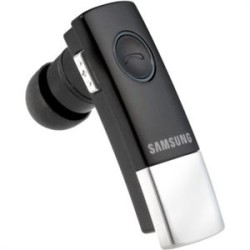
The WEP410 is small, light and lasts forever. It also recharges in an amazingly-short amount of time. I highly recommend it for anyone who wants a powerful bluetooth headset.
I upgraded to the WEP410 headset from the much smaller (but not nearly as long-lasting), Samsung WEP200 headset.
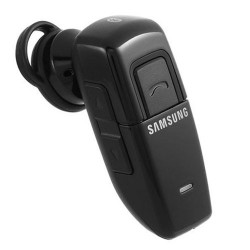
But my headset requirements grew over time and I now need more features and function out of them, given my new environment and surroundings.
The Aliph Jawbone (version 1) was the closest contender in this space and the demos and technology itself looked very impressive. The main problem was that the “Jawbone I” headset was H-U-G-E. I can understand that it needed that space to hold the filtering electronics, but… HUGE. And heavy.
The original Jawbone headset looks like this:
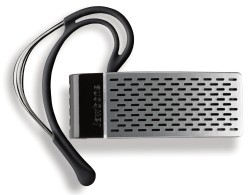
I prefer not to use ear loops to hold the headset over the top of my ear, so overall weight is a factor. I’m also pretty photo-sensitive (I have 20/10 or 20/5 vision, and I don’t like a lot of light in my eyes) and wear my Oakley X-Metal Frames a good portion of the day.
Most headsets that have ear loops (Jabra, Jawbone are you listening?) don’t work at all when you wear eyeglasses or sunglasses, so I have to use a “bud” style headset, or modify an existing headset’s ear piece to accept a bud. I’ve had to do this with the last 5 headsets I’ve owned, because the supplied “bud” is nothing at all like what a human ear can accept. I don’t know what they’re molding these headset buds to fit but it most-certainly is not a human ear.
Ironically, I’m still using the 6+ year old Jabra “EarGels” that I kept from that period, to keep my new bluetooth headsets secured firmly in my ear. They look like this:
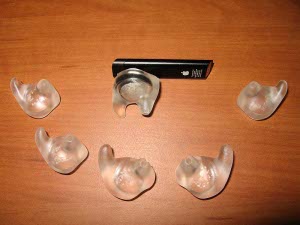
You can buy these now in packs of 6, in either clear or multicolor.
I did some searching and noticed that there was a new Jawbone version out, the Jawbone II (or Jawbone 2 as it is sometimes referred to). It promised better filtering, smaller/lighter fuselage and cost the same as the original. I decided to take the plunge and pick up one for myself.
The first thing you notice is that the packaging is absolutely stellar. It really was designed to showcase this product in every way. It is akin to a brand new concept car on a showroom floor. The plastic box, the matte-black cardboard containers inside, the directions… all of it.
The second thing you notice is that the outer surface is dimpled with a pattern that at first seems useless. It is similar to that “faux” carbon fiber look everyone is after these days. I KNOW carbon fiber. I’ve been riding a CF bike for over 8 years (complete with CF dérailleurs, handlebar, etc.), and CF has function. Fake carbon fiber does nothing but add fake aesthetics.
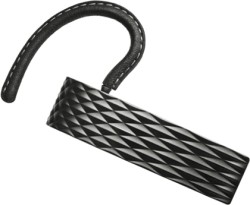
But the surface is more than just visual, it serves a purpose. When sound hits a flat surface, it tends to bounce back at an even rate. Because it’s hitting you at a level plane, you take the full audible hit. The surface of the Jawbone II (Jawbone 2) is dimpled in a way that breaks up the incoming (external) sounds and scatters them away from the headset, not directly off of it like a sounding board. Nice touch.
I tested a few calls with my head in the airflow of a very large air filter set to “High” as well as talking with my head within inches of my kitchen faucet with the water running full-blast. My unknowing “test subjects” barely realized that I could hardly hear them due to all the noise on my end, but they reported that MY side of the conversation was clear, crisp and without any significant background noise to distract or interrupt them… AT ALL!
There’s a few other really nice touches:
- The charger has a very slim wall-wart which accepts a USB male and the other end has a magnetic catch to hold the headset while charging. The wall adapter is ever so slightly larger than a box of wooden matches. No more bulky docking cradle, clip or proprietary cable required. They ship the wall wart and USB cable with the magnetic charging end. Well-done, Aliph.
- No more annoying blinking blue LED. Not only is the LED on the Jawbone II as thin as a cat’s whisker, but when you’re ON a call, it stops blinking, as it should. The LED on the Jawbone II is a simple white LED “sliver” when it is working, and a red LED when it needs to be charged (or is in pairing mode).
- Multiple choices of ear loops and sizes for the ear bud. Some headsets don’t give you a choice at all. Aliph included leather-covered ear loops as well as the simple plastic-coated wire version, in 3 different sizes for each. Again, a nice touch.
That’s good enough for me! I’ll put it to the test later this morning on the train ride into New York and see how it fares.
Now the downsides:
- There are no external buttons at all. I can understand the need to make an uncluttered interface, but you can hide the buttons so they’re not visible, without making the headset “fragile” while on a call. I was on a call tonight with the headset and was trying to reposition it in my ear (by shoving it back into my ear to hold it in place, because their ear buds were obviously molded for cow or pig ears). Pushing against the outside of the headset to put it back in my ear hung up on my call… because the ENTIRE HEADSET is a button. The whole outer skin of the headset is the hangup button. Ugh.
- No way to “bend” those ear loops without breaking them. They should be somewhat malleable so you can reposition them. In my case, I yanked them out and replaced it with a Jabra EarGels instead.
- No audible indicator when you’re “in” or “out of” filtering mode on the headset (the VSA or “Noise Assassin” mode). If you push on the headset (again, to stop it from falling off of your ear), you can inadvertently disable the filtering while you’re waiting for your next call. There’s no blink pattern or audible notification that lets me know I just disabled filtering. There’s also no way to verify that the filtering is either on or off by looking at the headset. Oops!
So far, I’m impressed… and so are my callers. They immediately noticed that my call was “crisp” and they could hear a lot more “detail” in my voice, which was a bit “muffled” and “muddy” with the last headsets I was using.
I’m going to really run this through its paces later this morning on the train into NYC, then on the subway and while standing in busy New York City traffic and sidewalk noise.
We’ll see how it fares. So far, I’m very VERY impressed.

Alan said on July 3rd, 2010 at 8:30 am quote
do you think I could use one with ‘in ear’ hearing aids?
The Nightly Charging Routine | random neuron misfires said on August 25th, 2010 at 12:29 am quote
[…] « First impressions with the Aliph Jawbone II Bluetooth Headset Fix for incompatible /usr/lib/gcc/x86_64-linux-gnu/4.2.3/libstdc++.so error message […]